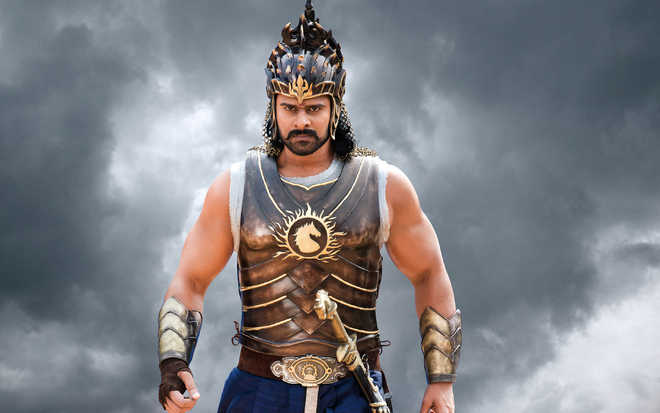Shardul Bharadwaj
The success of Bahubali 2 in North India is opening up a new market for a large range of films from Tamil Nadu, Kerala and Andhra Pradesh. Bahubali 2, the first dubbed South Indian film to have successfully completed a 50-day run in the North, is the first dubbed film to have grossed more than Rs 1 billion. It is being predicted that more Hindi-speaking audiences would go to theatres to watch South Indian films being released in Hindi. Some questions still remain. Which market are we talking about? Is it the same market that supports regionalised versions of Hollywood archetypal cinema, a market consisting of mass audience of entertainment, which is sated by the use of prevalent cultural stereotypes? A lot many have argued for the genuinely different and good content that has made Bahubali 2 work.
Bahubali 1 and Bahubali 2 are major departures from a typical Telugu action flick. The film is a fictional mythology dressed up as historical fiction; there has been an attempt by the director to take the audience into a world of fictional past. The film does not just work on the presence of stars; Bahubali 2 was mostly marketed in the name of director S.S. Rajamouli. The dubbing of the film has been done to match the lip sync of actors actually speaking in Telugu. The film has also worked due to the depiction of an imagined Brahminical past.
The Hindi dubbing has been faithful to the original. All the villagers and lowly denominators in the film speak in Bihari (commonly misunderstood state language of Bihar and Uttar Pradesh) while the Royals speak Sankritised Hindi.
It has been a common practice in dubbing to use popular language stereotypes for marketability. Bindass, a TV channel, worked on dubbing films from all over the world into neatly stacked stereotypes of languages and personalities in common parlance. For example, a Black man would mostly have a Punjabi accent because of the happy-go-lucky tag associated with both the communities.
Dubbing and subtitling have often been understood to be mediums of cultural exchange. During the 1940s and 1960s, the dubbing industry of Iran gave its audiences the most popular films of Hollywood and Bollywood; Bollywood films became so popular that the Iranian new wave cinema had to try hard to make people accept non-Bollywood tropes. Controversies have arisen in Karnataka and Bengal when big Bollywood films like Gunday (2014) have been slated for a dubbed statewide release. Big names in the West Bengali film industry went on protest when Yash Raj Productions wanted to release Gunday in Bengali. The rationale behind the protest was that big names from Mumbai should not come and infringe upon the spaces that vernacular film industries hold. Similarly, Chennai Express (2013) faced flak in Kollywood for not only bad filmmaking but also trying to release the film dubbed in Tamil in Tamil Nadu.
Clearly, markets are the primary reason that a film is dubbed today. A Hindi film will only be dubbed in a vernacular language to be given big releases in a vernacular language region when the film would have the potential of making big money in that region. On the other hand, for a vernacular film like Bahubali 2 to be dubbed in Hindi would involve all major stereotypes — from cast, history to language — to be able to make the film lucrative in terms of money. Dubbing has worked in our country for long because of massive illiteracy rate, although the audiences were hardly ever given the chance to watch films with subtitles; the subtitles are generally in English for vernacular films, if these are there at all. This leads to a small section of English-speaking urban population getting access to gems of vernacular language films.
The rest of the population has to make do with standardised stereotyped version of action films like Robot (2010), Vishwaroopam (2013) or other action flicks from Hollywood like Spiderman, Batman Returns, etc.
Audiences in North India have hardly ever been comfortable with watching vernacular language films with subtitles. The dubbing, however efficient, will always leave a jarring effect due to the gap between the language spoken in the film and the dubbed language. Years of training in watching dubbed American cartoons might have helped bridge this gap but the fact remains that dubbing of an entire film is such a cost-intensive enterprise that it can be taken up by only big players who aim to mostly make profits out of cinema. The creatively more engaging films like Visaranai (2015), Angamaly Diaries (2017), etc. will always remain on the fringe because of lack of subtitles in vernacular languages.
Unlock Exclusive Insights with The Tribune Premium
Take your experience further with Premium access.
Thought-provoking Opinions, Expert Analysis, In-depth Insights and other Member Only Benefits
Already a Member? Sign In Now










